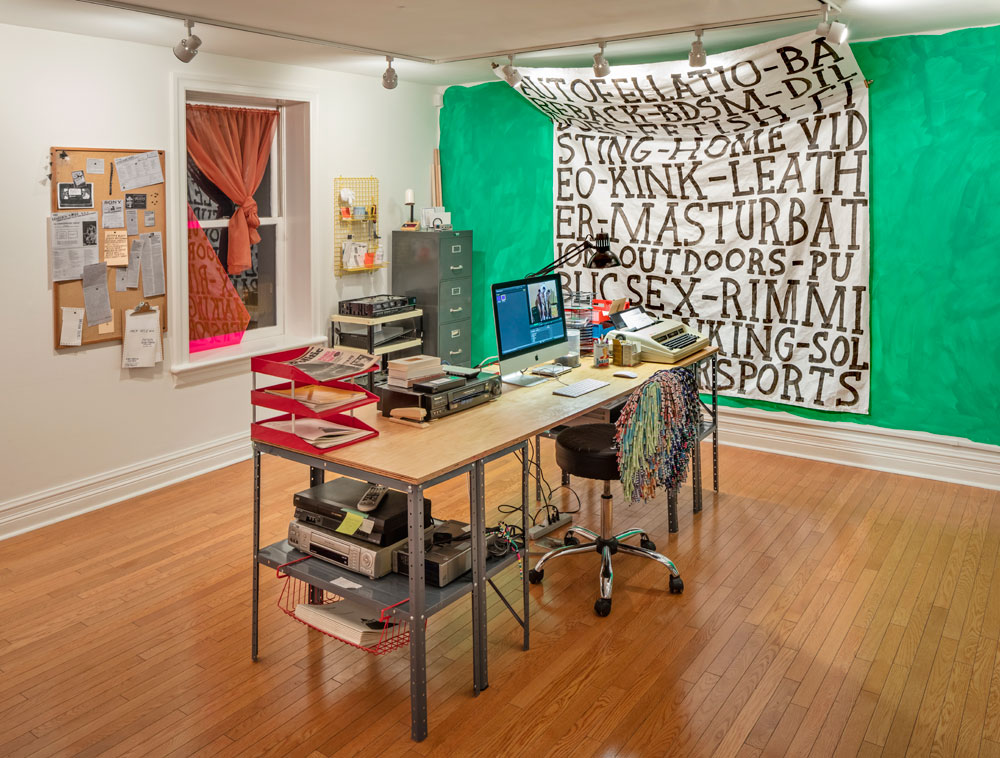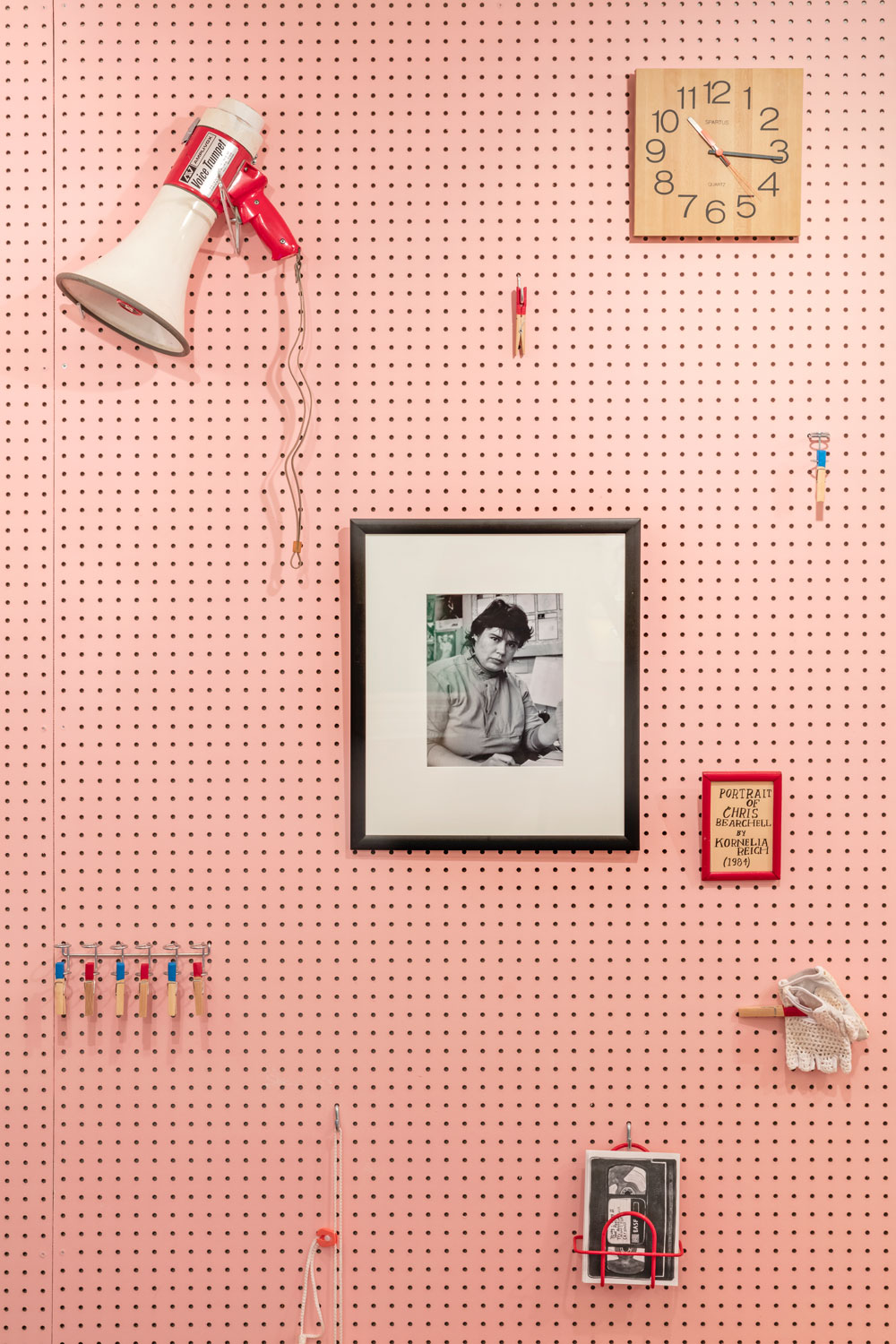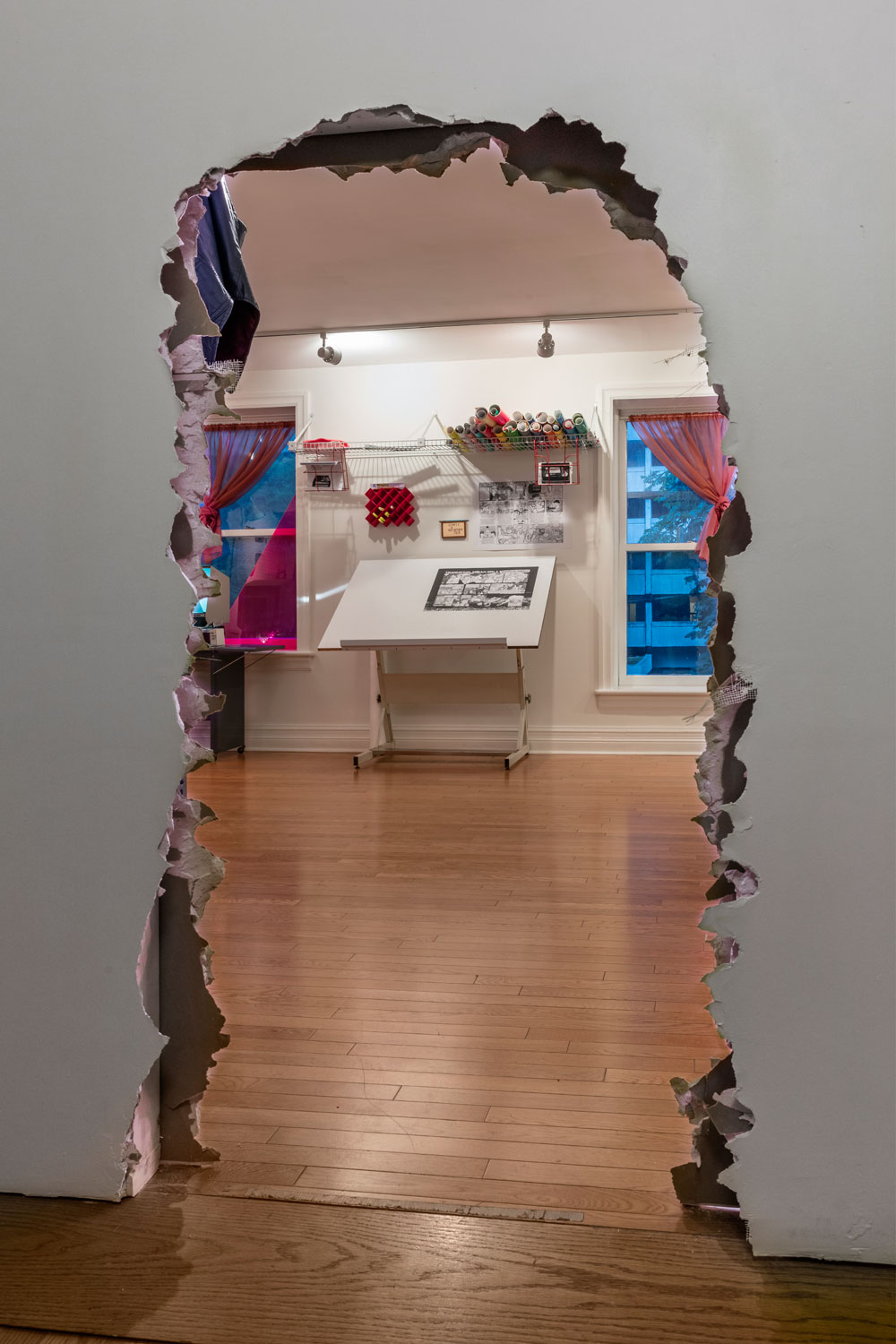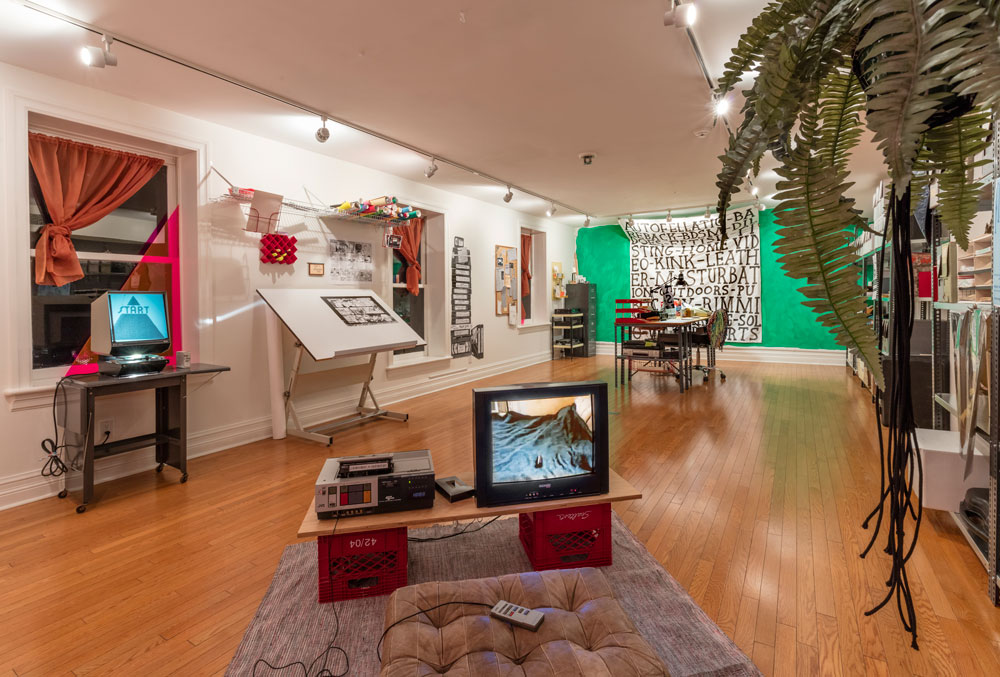To some people’s delight and some people’s dismay, identity politics are back, with a vengeance. While fashion and politics seem to come and go in 20-year cycles, repeating -isms ad nauseam, the return of the same systematic roadblocks is disconcerting for the generation who experienced their first full cycle.
Speaking with Hazel Meyer and Cait McKinney about the reception of their current collaborative exhibition, “Tape Condition: degraded” at the Canadian Lesbian and Gay Archives (CLGA), issues of disavowment perpetually rear their ugly heads. While those who managed to cross east of Yonge Street have offered glowing reviews, Hazel notes that few, if any, of their non-queer art friends have bothered seeing the show. The deeply seated and internalized fear of making or being too gay for professional value is a legitimate fear.
Unfolding as a deep lez bro down about the trajectory of gay liberation, sex dungeons, gossip, and what we want to see in the art world, Hazel and Cait are joined by writer Amy Fung for an exercise in searching for and writing out your own mythologies.
 A view of “Tape Condition: degraded” by Hazel Meyer and Cait McKinney. Image courtesy the artists. Photo: Toni Hafkenscheid.
A view of “Tape Condition: degraded” by Hazel Meyer and Cait McKinney. Image courtesy the artists. Photo: Toni Hafkenscheid.
Part 1: Chris Bearchell
Sipping tea from a classic Garfield mug, Amy is surrounded by a mélange of sport shorts, tank tops and planters filled with kale, herbs and chard growing all around her. It’s a weekend morning in a Toronto west-end neighbourhood and Amy, Hazel and Cait keep moving their patio chairs to stay out of the sun. Nobody speaks about the failed cucumbers. On the patio table, a single can of Super 8 film sits among the piles of papers. This can holds the only remaining copy known to exist of the late Chris Bearchell’s homemade porn. Up until a couple of months ago, its existence was only ever a dream.
For those who know, Bearchell was an inimitable leader in the Canadian gay liberation movement. She was an intersectional feminist before intersectional feminism was defined. She fought against racism, for sex-worker rights and for gay mother’s rights through the scope of a gay liberation movement that fought for equality for all. She was a fierce opponent of obscenity laws in Canada and wrote a lot about porn, watched a lot of porn and made her own porn. Cait and Hazel have been searching for Bearchell’s porn for years, eventually turning the premise of their re/search into the premise of their collaborative installation/dungeon archive exhibition at CLGA, which offers a thoughtful consideration of what has been and continues to be left out of history.
Amy starts with what she sees. She asks them to tell her about the bubblegum pink pegboard in the show at CLGA, and again in their kitchen just beyond the screen door. Hazel, whose solo practice has shown across the country and has been gaining international interest in recent years, relays that they didn’t want nostalgia. They wanted a functional perv zone, like an S&M dungeon where you can see all the tools of what’s available. She recounts the moment when she was going through Chicago’s Leather Archives and Museum tumblr and just seeing this beautiful dungeon with wall-to-wall pegboard. To see all the floggers, blindfolds and tools you could use on someone is part of the experience. Her eyes go wide and she turns to Cait for her thoughts.
Cait, who is an academic in media and gender by trade, but has been working at CLGA and researching this exhibition with Hazel for the past three years, begins speaking on the aesthetics of display and how the pegboard allows someone to take in all the possibilities that you can use on someone or have used on you. They are as powerful as the objects themselves, she beams.
Attending their collaborative performance lecture at Buddies in Bad Times in July, Amy learned that a copy of the mythical Bearchell porn had recently been recovered through Evalyn Parry (Buddies’ artistic director), who has a friend who appeared in Bearchell’s porn and had an original Super 8 copy among her personal belongings. It was made in an era when most homemade porn was shot and circulated on Polaroid or VHS, Amy asks Cait and Hazel to speculate on why Bearchell would shoot on Super 8 and how they feel about finding a film reel instead of a VHS copy. Their performance lecture focused on the distribution and articulation of homemade porn through the aesthetics of VHS, an aesthetic of daisy chains and access.
Admitting that the possibly disintegrated can of Super 8 stresses them out, the biggest unknown is that they haven’t even tried to watch it yet. Pointing to the difficulty of finding a well-lubed Super 8 projector and someone with the knowledge to run it in Toronto, as well as having the right politics to see it, they have been waiting for Milada Kovacova for their first screening. Millie’s 8 Fest programs on feminist erotica have been excellent and diligent in uncovering radical long lost works by filmmakers who would and have been otherwise forgotten by the majority. Amy nods in approval that they are waiting to watch it with Millie, even if the anticipation is killing them. They want this to be seen first by those who have been looking for it. Millie has also been searching for years. A technician digitizing it does not need to see it first. Hazel says this emphatically. Cait also points to the ethics of showing this work, about the need to track everyone down if possible. It’s a daisy chain of ethics in showing long lost porn.
From their performative lecture, the viewer learns that:
A daisy chain is the DIY method of bootlegging tapes from other tapes.
A daisy chain sacrifices fidelity for access.
Daisy chains lie just a little bit outside of time
They exist to amplify and multiply what’s already been recorded
But with an ethos of sharing, circulating
Even if the original gets distorted in the process.
They speculate on what Bearchell’s porn will look like. Most of this interview becomes speculation and gossip. Hazel remembers hearing about Bearchell from a stop-motion animation put out by the NFB, either called Feminist Five Minutes, or as she likes to remember it, Five Minutes for Feminism. Because we all only need five minutes, right? Bearchell was trying to be the voice of the gay liberation, a movement which was mostly dominated by white men. Cait’s takeaway is that sexually radical women were central in that struggle, which was ultimately intersectional and has been historically whitewashed. Everyone remembers the bathhouse raids, that men got arrested, fought, demonstrated and politicized Gay Canada was born. Hazel makes ironic rainbow hands. There are far more complex stories of gay spaces that have always existed and that have always included intersectionality before it became a theoretical buzzword. People like Tim McCaskill prioritize more nuanced histories. Everyone feels important to note that long-time Toronto gay activist and queer elder McCaskill’s new book, Queer Progress: From Homophobia to Homonationalism, comes out soon.
 A detail of the massive pink pegboard in Hazel Meyer and Cait McKinney’s “Tape Condition: degraded.” Image courtesy the artists. Photo: Toni Hafkenscheid.
A detail of the massive pink pegboard in Hazel Meyer and Cait McKinney’s “Tape Condition: degraded.” Image courtesy the artists. Photo: Toni Hafkenscheid.
Part 2: Tape Condition: degraded
A few years ago, Cait and Hazel went on a date to see “Sex Lives and Videotape” at the CLGA, an exhibition which proposed itself to be a survey of the VHS archive. They imagined the show to be a spank bank of cum shots, but instead it was about 40 copies of Beaches and Philadelphia. After the initial disappointment, they realized they were inspired to nurture a different relationship to the CLGA archive. It clarified their interests, as partners and lovers, and what they would like to see as a survey show of the gay archives. As in a lot of Hazel’s independent practice, they wanted to highlight the parts of history that, on the surface, don’t seem to matter enough to record. Pointing to this one photo by Jearld Moldenhauer, Bearchell is seen wearing padded leather gloves with a crocheted rainbow top that she wore to all demonstrations. Hazel salivates that you just know Bearchell wore them in all aspects of her life. Were they fingerless? Amy asks. Deep nodding. Of course they were.
That’s how the research started, by looking for the lost histories not covered in any history book. Beginning in fantasy, Cait and Hazel started with compiling Dream Tapes, proposing to 11 other artists to answer the question, “What would you look for in the archives?” Artists Anthea Black, Derek McCormack, Ginger Brooks Takahashi, Guillermina Buzio, jes sachse, Jessica Karuhanga, Kiley May, Morgan M. Page, Nica Ross, Nick Matte, Syrus Marcus Ware answered, and, alongside a new video by Aidan Cowling and publication designed by Cecilia Berkovic, the exhibition has also been a functioning digitization space situated upstairs at the CLGA.
To get to the installation, viewers have to crawl through a hole in a purpose-built false wall. The idea of the false wall came from Bearchell, who allegedly spoke about storing all of The Body Politic’s porn behind a false wall when police raids started targeting gay spaces. Cait heard about this moment from Rebecka Sheffield, former executive director of CLGA. It’s unclear if this comment was recorded in the meeting minutes for CLGA or The Body Politic, one of the first publications in Canada dedicated to gay content and where CLGA first formed. At the time, censorship debates were raging after Gerald Hannon’s 1977 article “Men Loving Boys Loving Men” came out in the The Body Politic. The newspaper’s office was raided by police and the publication was charged for distributing immoral, indecent or scurrilous material before being acquitted, twice. While localized gay history remains a footnote in most civic texts, Amy asks if they think this show could exist outside of the CLGA context.
Hazel would like to have the option of reincarnating this show into another space like a museum or artist-run gallery, but Cait believes the project is site-specific. She relays that when visitors crawl through the false wall and enter the exhibition space, the dislocation of whether they are still in the archives or not is an important element for the show. The exhibition functions differently for people who regularly interact with CLGA.
Not everyone who comes to see this show will immediately understand that it’s an art exhibition. Not everyone who has come to see the show regularly visits art exhibitions. It’s a different space within the institution of the CLGA, which itself has a deep-seated history where not everyone has always felt welcome.
Speaking specifically about the Dream Tapes, Cait continues that they couldn’t be in this space and not be more responsible. The imperialist white supremacist capitalist patriarchy of CLGA’s history is real for many, and this show intervenes into that history. So how do you change history? Cait and Hazel wanted to invite more voices than just their own and make that invitation into more than just a gesture. Each artist needed to reflect on more than just the categories they are meant to represent, and at the same time, each artist by default carries a politicized commitment which refuses and transgresses the categories they are being asked to fulfill.
Amy wonders aloud if the gestures and allyship will ever be enough and who is really doing the labour of making the change? She is not asking to provoke an argument, yet many times white fragility prevents a conversation. It doesn’t happen this time. They all sip their tea and consciously verbalize that it’s often the people who are politicized who will inevitably do the hardest work in fighting injustice, and any allyship that speaks on anyone else’s behalf is just bad allyship. So how do you stay present and support each other?
Gossip in the art world is how women and queer people take care of each other. Cait is paraphrasing Gabby Moser paraphrasing Helena Reckitt. RIP José Esteban Muñoz. In the hierarchal power fuckwad that is the art world, gossip is a tool to spread news on the abuses of limited power. Cait is not entirely sure she is getting the quote right, but misremembering is part of the daisy chain of gossip. Most of the exhibition’s research is based on anecdotes, gossip and unofficial histories. There’s a power in that. Stories that otherwise wouldn’t make into books and other forms of official histories still find a way to reach those who need to hear it.
 Hazel Meyer and Cait McKinney’s project “Tape Condition: degraded” is accessed through a hole in the wall at the Canadian Lesbian and Gay Archives. Image courtesy the artists. Photo: Toni Hafkenscheid.
Hazel Meyer and Cait McKinney’s project “Tape Condition: degraded” is accessed through a hole in the wall at the Canadian Lesbian and Gay Archives. Image courtesy the artists. Photo: Toni Hafkenscheid.
Part 3: Flaps and Whistles
Speculating on why and how gay liberation went the way it went, specifically the dominance of middle-class values in privileging gay marriage above intersectional support across lines of class and racial equality, the three of them paddle around the nuisance of patriarchy and how it ruins everything. State-sanctioned violence and control of bodies has always been a predominant factor in how stories enter the public consciousness. Cait brings up the Toronto Police’s recent apology for the 1981 bathhouse raids during Pride Month as a complete pinkwashing of the brutalization the police continue to enforce on queer and trans bodies of colour. A well-timed and public apology is a comfortable story for Canada, but it’s actually not good enough. We need to refuse the apology and refuse to be the thing they are apologizing to, namely that police violence towards LGBT people is over, when police brutality and incarceration of queer bodies have never ended.
Hazel wonders if there are still spaces where queer bodies can get messy, and they are all confused because it feels like EVERYBODY is a messy queer these days. They all laugh and laugh at the straight white men claiming queerness. Cait thinks it’s great from an education point of view if more inclusive safe spaces are made available for young people. She doesn’t need curmudgeonly older gays reinforcing LGBT marginalization to keep her politics alive. Refusing to inherit the legacy of past generations is not disrespectful, which she knows a lot of people perceive it to be. It’s not a personal critique that the legacy doesn’t work for everyone, but let’s recognize the tremendous loss by the generation before us.
At this moment, a pompadour pokes up from the stairs leading up to the balcony. Anthea Black is stopping by to pick up a camping cooler and Hazel and Cait share some deep lez knowledge about what kinds of ice packs to bring for the road. Splurging about the rock formations she is about to go visit on the Bruce Peninsula, Anthea has a strong reaction to our discussion of the current wave of over-identification with queerness. A long-time sex-positive queer activist and artist, she snarls for all of them to GO HOME! She’s so sick of it, but she echoes that the same thing probably happened in the ’90s during times of intense identity politics. She says with no irony that it’s retro to be queer. As now was then, people were bugged about how queer everyone suddenly became and straight-cramping queer lived-experience still makes us prickly.
Was it Helen Reed or A.L. Steiner who brought the word “lesbian” back into daily conversation? Cait doesn’t want to police anybody’s sexuality, but recognizes the performance of queerness is real. Yet, the language of queerness is not yet real. Not real enough to be taken seriously. Professionalism enacts a form of xenophobia against what we understand to be unprofessional, namely, that which is not white, male, and middle-class. Hazel is reminded of the time Hannah Jickling wrote a grant for a vagina skateboard park and didn’t get the grant. When Hannah asked for feedback from a friend and peer who had more grant writing experience, the comment was that Hannah may have used the word “vagina” too much. There’s still no place for too much vagina because misogyny, sex phobia, but really and foundationally, vagina does not read as serious. A wall of dicks reads like a major museum retrospective or a private collector’s living room, but too much vagina must be a joke. Do we need a wall of vags? Allyson Mitchell did that already. For sure Allyson has done that already. Hazel thinks we need a venue to explore all the other flaps and holes and whistles down there. So what makes an object an art object to you? Is it something that can be institutionalized and commodified?
Financial support is a real thing for Hazel and the ability to survive from her work is really important, but support (be it financial, institutional or peer-to-peer) to create more magic perv zones as a legitimate professional practice shouldn’t become less real. She shares that her dream fantasy project is to create a sporty and magical romper room/sex dungeon, where unscripted human beings can interact with one another. But will that project ever be taken seriously by the art world? And what does that even mean? It goes back to her initial reaction to only having deep art queers show up to their show. Could it be because the show was about pornography? Or that it was mostly about a lesbian activist, whose politics were radical, but doesn’t necessarily fit into a twin braids neue font cool hip queerness?
Cait fondly recalls that earnest lesbians who only speak of the struggle of past institutions are what theorist Heather Love sweetly calls “gentle dinosaurs.” No joke, Hazel recounts that most visitors wouldn’t come see the show unless they came in an Uber to go see and support those two women artists making community art off of Church Street. Amy admits she arrived that way. All Hazel wants is to grow into a ripe old age to do this kind of work, to make work her romper room dungeon and be taken seriously, but for now, the world is not ready for all the other flaps and holes.
The run for “Tape Condition: degraded” has been extended at the Canadian Lesbian and Gay Archives until September 23. (Previously, the show was slated to close September 18.)
This article was corrected on September 20, 2016. The original copy referred to a past event at the CLGA as “Sex, Lies, and Videotape.” The correct title of that event was “Sex Lives and Videotape.”

 A view of "Tape Condition: degraded," a project by Hazel Meyer and Cait McKinney at the Canadian Lesbian and Gay Archives melding references to porn, queer history, S&M and more. Video in foreground is Landscape of Infinities by Aidan Cowling. Image courtesy the artists. Photo: Toni Hafkenscheid.
A view of "Tape Condition: degraded," a project by Hazel Meyer and Cait McKinney at the Canadian Lesbian and Gay Archives melding references to porn, queer history, S&M and more. Video in foreground is Landscape of Infinities by Aidan Cowling. Image courtesy the artists. Photo: Toni Hafkenscheid.







